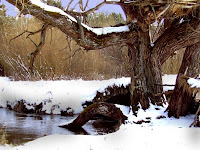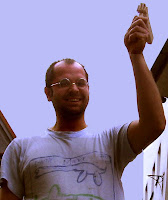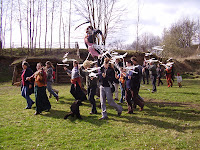
Phil's contribution below has prompted me to tell you about the hundreds of little shrines and chapels that you can find by the roadsides here, but also dotted about the countryside, even hidden in the middle of forests. Potok in her own blog, and I in this, have both mentioned them already, but maybe these little gems deserve another look.

In the old days, these shrines and chapels served two main purposes:
1/ to mark the travellers' and pilgrims' paths from monastery to monastery, or 2/ to provide a circular route with the Stations of the Cross, which served the Catholic pilgrimage festivals (the most remarkable of these circular routes in this area is by the
village and monastery of
Římov, well worth a visit). Then there are the odd solitaires - suddenly in the middle of nowhere, you will find a cross or a small shrine seemingly out of context - but these usually mark places where someone wanted to give thanks for a fortunate meeting, or had some moment of revelation, or they mark a spring that used to be regarded as healing.

Then of course there are also the 'guardian' crucifixes or shrines, usually at some crossroads, because even in the pre-Christian, pagan, times, the crossroads were always regarded as magical places, where witches and devils might have lurked, so the shrines and the crucifixes are there for the protection of the travellers.
Well, some of the old paths have by now become major roads, some fell into disuse or were planted over by forestry. But even in the dense forests, wherever you should come upon such a forgotten shrine that seems like something out of a dream, you

may be certain that the ground nearby bears a distinct groove where the ancient road would have been, and where you can imagine the hundreds of feet and horse-hooves that once trod this well-worn path. I am told that if you follow these monastery-to-monastery paths*, you are actually walking on ley-lines, as the monasteries were already built on places of such power. That's if you like to believe in these things.
The photos here are from a walk I took in the Autumn, a walk that starts with a shrine outside our house and leads into a forest not more than a mile away. This beautiful little chapel on the right (consecrated, so people still hold services there) has beautifully carved seats and a proper altar -

and further on, right in the depth of the forest, is this tall, narrow shrine with no opening at all - the legend has it a nun was walled into it as a punishment for an affair with a monk, who, in turn, came in the night to break the walls to rescue her. A long story, which would take too long to tell here, but another impulse for contemplation when one stops for a moment on one's forest walk.
Phil is right to mention the statistics about the Czechs being the most Atheistic nation in Europe, but they love their shrines (they survived, relatively, even during Communism) and even now, as you pass, you can see in almost every one of them at least a little flower, if not a candle or a picture, because you never know, they might still hold the power to grant your wishes or have your prayers answered :-)
*These paths make wonderful walking itineraries. See www.mapyonline.cz where you can purchase a map that clearly marks all the hundreds of chapels and shrines - Shocart, No 36
 What, now, after Easter? Well, Winter obviously got re- surrected so we couldn't resist the snow, and drove down to Sternstein in Austria (40 mins South of Krumlov). There must have been all of ten skiers altogether on the beautifully prepared slopes today, and the conditions were truly fantastic - nice and fast on the piste, and fluffy through the trees. Wow.
What, now, after Easter? Well, Winter obviously got re- surrected so we couldn't resist the snow, and drove down to Sternstein in Austria (40 mins South of Krumlov). There must have been all of ten skiers altogether on the beautifully prepared slopes today, and the conditions were truly fantastic - nice and fast on the piste, and fluffy through the trees. Wow.
































